Baja California July 2012: 2,622 miles
Day 1 (Saturday July 14th): To Shell Island via Tecate, Mexicali, San Felipe.
Day 2 (Sunday): To Bahia Concepcion via Coco’s Corner, Calamajue, Guerrero Negro, Santa Rosalia.
Days 3, 4 (Monday, Tuesday): At Bahia Concepcion plus Mulege dinner.
Day 5 (Wednesday July 18th): To La Paz via Loreto and Ciudad Constitucion.
Day 6 (Thursday): To El Triunfo, Real de Santa Ana, San Bartolo, Los Barriles, Punta Pescadero, San Juan de los Planes, La Paz.
Day 7 (Friday): La Paz Museums, La Balandra, El Tecolote.
Day 8 (Saturday): To Todos Santos, El Pedrito, Cabo San Lucas, El Tule, San Jose del Cabo, Santiago, Las Cuevas, La Paz.
Day 9 (Sunday): To: Isla Espirito Santo, Isla Partida, Las Tres Virgenes Restaurant.
Day 10 (Monday July 23rd): To Bahia Concepcion via Las Pocitas, Cd. Constitucion, Ligui, and Loreto.
Day 11 (Tuesday): To Bahia Asuncion via San Ignacio, Punta Abreojos, La Bocana.
Day 12 (Wednesday): At Juan y Shari’s Bahia Asuncion Bed & Breakfast, Fossil Hunting.
Day 13 (Thursday): To Bahia San Rafael via Vizcaino, Pozo Aleman, San Francisquito.
Day 14 (Friday): To Shell Island via Bahia de los Angeles, Laguna Chapala, Bahia San Luis Gonzaga.
Day 15 (Saturday July 28th): To San Diego via San Felipe, Mexicali and Tecate.
A week before our trip began, we did a run to Tijuana to get our tourist cards (also called an ‘FMM’, it is like a visa needed for trips beyond the border towns or stays over 3 days). The fee for an FMM (valid for 180 days) was 290 pesos or US$24, each The INM office at the Tijuana border is open 7 days a week from 6 am to 10 pm. The INM official can now receive the payment, so no need to have an open bank nearby, as in the past. We also purchased pesos at the Chula Vista Costco money exchange (Palomar exit, I-5 to Broadway, north) for some of our trip purchases (mostly gasoline) and the exchange rate was 12.905 pesos per dollar. Except for the border region gas stations, the cost of gasoline was $2.95/ gallon (10.05 pesos/ liter).
If I post a price in pesos, the equivalent dollar value will be shown.
--------------------------------------------------------------------------------------------------------
Saturday, July 14: Crossed the border at Tecate 11:14am. When entering Mexico there is a red light/ green light signal to tell you to continue on in or to pull over for inspection. Being a pickup truck full of stuff, we got a red light. Since Tecate is a very quiet border going into Mexico, it took just a few seconds for the officer to glance at my truck and tell me to continue on into their country. They are looking for items that may be resold in Mexico such as appliances, electronics, etc. Camping and personal gear is no problem.
Signs point the way towards Mexicali making the little bit of city street use very simple. Just east of town on Highway #2, we stop at a Pemex station and topped the gas tank. price of 87 octane ‘Magna’ from the green/ ‘verde’ pump was $3.02/ gallon (slightly higher price along the border). Got on the toll highway (Highway #2-D) towards Mexicali for a quick 80 mile trip east to Highway #5 for San Felipe. Toll at El Hongo was 57 pesos (or posted US$4.30), toll at La Rumorosa was 20 pesos ($1.55), and final toll near the junction with Highway #5, was 60 pesos ($4.65).
Highway #5 has been torn up for widening in sections for the past few years and during this trip, there was a total of 20 miles of unpaved detours along the new road work. This is in the area 47 miles south of the Highway 2-D junction (at the sand dunes) to El Chinero mountain (between the active gold mine and Highway 3 junction). The detours were mostly smooth and watered down for dust control.
At the Highway 3 (Ensenada) junction, 160 miles from Tecate is the first major military inspection where soldiers may ask you to step out of your car so they can look for illegal drugs, guns or ammo. They are always polite, friendly and very quick (at least to us). Most of the time they will ask you where are you coming from and where are you going. In a couple locations they recorded my name and asked what year model my Toyota Tacoma was (2010). Showing them your driver’s license makes their writing of your name easier. They never asked to see passports or tourist cards, and never have on any of my trips… as it is not in their duty of looking for guns and drugs.
At El Dorado Ranch, we stooped to top our gas tank. This is 7 miles north of San Felipe, just past the big ‘Rockodile’ sign (a crocodile). The price here is the same as at all other Baja stations for this trip with one exception and the border zone price. Magna (Regular 87 octane) is 10.05 pesos per liter or $2.95 per gallon. If you are using dollars, this station was giving an exchange rate of 13.00 pesos per dollar. I took on 10.5 gallons for the 183 mile drive from Tecate. The convenience store at the El Dorado Pemex had 8 packs of Tecate Light Beer for 84 pesos ($6.46 for 8 cans).
We left the station at 3:30pm, drove the 7 miles to San Felipe, turning south at the traffic circle. In 6 miles, a left turn is made (ahead goes to the airport) and this point is also Kilometer 0 for Highway #5 south. Several vacation home and camp areas are passed as we head for a very special beach I have been camping on for the past 34 years, before most of the region’s development and before paved roads ventured south of San Felipe. It is a barrier island that during the highest tides is surrounded by water and impossible to access or leave. Being difficult to get to is one reason it remains as beautiful today as it was the first time I camped here, on the beach I call ‘Shell Island’. The access road to the island is near Km. 26, almost 22 miles from San Felipe. We arrived at our campsite at 4:40 pm. Our vacation had begun!
Photos:
After crossing the salt/mud flat, we reach the beach on the island.
While the entire 4 mile long island is usually deserted, we have a favorite spot next to the dunes a couple miles away from the road.
Elizabeth quickly gets into the ‘Baja Feeling’ mode…
… and makes her first contact with the Sea of Cortez.
Whelk eggs were spotted on the wet sand. A whelk is a large sea snail.
New, easy up tent! Our last time camping here (July 4th weekend, 2011) a sudden strong wind devastated our camp and ruined our old tent. That same wind sunk the sport fishing ship ‘Erik’ with many lives lost, about 50 miles south here.
Sunday, July 15: We woke up with the sun and soon were packed up.
Here are views north and south on Shell Island:
To Be Continued...
===============================================================
Sunday morning we got moving south at 7:38 am and reached the Puertecitos entrance road in an hour (time includes adding air to the tires once we were off the deep sand of Shell Island). The Puertecitos road is at Km. 74.5 and the new, wider, high speed highway begins here. The 52 mile highway from San Felipe to Puertecitos is an older style, narrow paved road with sudden, steep vados (dips) that prohibit high speed. I reset my Tacoma’s trip odometer at the Puertecitos junction to note the mileage where the new pavement has reached, and other points south.
Playa Cristina is at Mile 5.0, La Costilla is at Mile 6.1, the wide turnout with the view of the Enchanted Islands is at Mile 14.7 and just before Km. 100 marker. Okie Landing (a fishing ‘resort’ from the 1960’s with just concrete slabs remaining) is at Mile 25.5/ Km. 117. The pavement ended just north of here one year ago.
The end of pavement this trip is at Mile 31.3, just beyond Km. 126. That is almost 6 miles (10 km.) in one year. This is no rush job, but the quality of the highway is fantastic, with a 110 kph (~70 mph) speed limit.
Turnoffs to Campo Delfines is at Mile 31.9, Punta Bufeo is at Miles 36.6, Papa Fernandez’ is at Mile 41.7, Military checkpoint is at Mile 42.8, and the Pemex gas station/ Alfonsina’s road/ Rancho Grande store are at Mile 44.2 from Puertecitos road and the time was 10:06 am.
The remaining unpaved road to Bahia San Luis Gonzaga is graded smooth. From the end of pavement to the Pemex and Rancho Grande is 12.9 miles. We topped the gas tank at Gonzaga Bay. Trip odometer reset to 0.
Las Palmitas oasis/ El Camino Real access road is at Mile 7.2, the first boojum (cirio) trees were at Mile 13.9, and Coco’s Corner is at Mile 22.4. We were at Coco’s from 11:00 to 11:52 am. It was a nice visit, Coco seemed quite happy, and his only request was for a new battery for his quad. Otherwise he gets around on a wheelchair or walks on his ‘stumps’.
At Coco’s when we arrived were a couple from Ventura in a Jeep Wrangler with good off road tires. They wanted to go south through Calamajue Canyon, but Coco had told them the water was too deep for them to take the ‘risk’. Just a couple weeks earlier, Bajatripper had passed south via Calamajue and reported the stream much smaller than typical and the water was no problem for his Toyota 4Runner. I told the couple that they could follow me and I would be happy to pull them through with my Tacoma, if needed. Coco said he wouldn’t take responsibility for them, and I assured him that I would!
There are two roads southbound from Coco’s Corner, the most used one is the main road to Highway #1 at Laguna Chapala which is graded and will be the route or close to the route of the future paved highway. The other goes through Calamajue (say: ‘Cal-a-ma-WAY’) canyon is was the main route south before 1983 when the graded road from Laguna Chapala was completed. For several miles, the road and the year-round stream of mineralized water are one in the same. The Baja 1000 race often uses the Calamajue route, and that often creates a difficult drive until nature repairs the damage. The road begins heading east and for 6.3 miles is a graded road that continues to the Sea of Cortez (also called the Gulf of California) at Puerto Calamajue. The road we want turns south off the graded road and in 6.6 miles arrives at the top edge of the Calamajue river gorge. To the left here are ruins of a gold ore processing mill from the early 1900’s. The road drops to the valley floor and at Mile 13.1 from Coco’s Corner a faint track goes to the left and climbs up the opposite bank 0.4 mile to the first site of the 17th Spanish California mission, founded in 1766. Only there for a few months, the mission was moved because the water was far too salted with minerals to grow any crops. The new location was given the name Santa Maria de los Angeles and the first location has typically only been known as Calamajue, the local native Indian name (however one Jesuit missionary wrote that it was first called Nuestra Señora de Columna).
We made lunch next to the ruins of the mission and rock corrals, probably built by miners years after the mission period ended. We got on the road again at 1:25 pm and soon were driving in water and across only a couple of deep puddles, but no challenge at all for either the Jeep or Toyota. At mile 21.1 from Coco’s Corner (not including the side trip to the mission) we were out of the canyon and passed the access road to Highway 1 at Km. 251. This cut across road was built in 1973 during the building of Highway 1 to get water, needed for compaction of the roadbed. The next 6.9 miles are mostly slow because of the whoops (short, deep bumps) usually created by race traffic. After passing Rancho El Crucero, opening the gate across the road (and closing it behind us), we reach Highway 1 at Mile 28.0 from Coco’s Corner and at Highway 1, Km. 261. We add air to the tires for highway running and are on our way at 3:02 pm. The couple in the Jeep headed for Bahia de los Angeles to finish their vacation.
Reset trip odometer to 0 at El Crucero/ Km. 261. Mile 13.0 is the Bahia de los Angeles junction. The next military inspection station is at the turnoff to El Tomatal, near the Pacific coast of Baja California. Mile 69.9 is the Villa Jesus Maria Pemex station (121.2 miles driven since Gonzaga Bay gas fill-up) and after topping off we are southbound at 4:20 pm.
Normally, one expects to show his tourist card at the state border, near Guerrero Negro and typically, this is the only place were you are asked to show it. A big stop sign is in front of the immigration office, just a bit south of the huge steel eagle and traffic circle, built on the state border between Baja California and Baja California Sur. We stopped, anxious to show the officer our papers, but he just glanced from the doorway and waved us on.
The southern half of the peninsula is on Mountain Time, so we advance our truck’s clock from about 5 pm to 6 pm. Also the kilometer markers work in reverse, getting smaller as you drive south. We pass through Vizcaino at 6:48pm (65 miles south of Villa Jesus Maria). We pass by San Ignacio (Km. 73) at 7:30 pm after another military check. Now, if it is your first time into Baja, do not pass San Ignacio without taking the short paved road right, to the plaza, to see this beautiful oasis and giant stone mission church.
The highway makes two steep drops to the Sea of Cortez, the second is the steepest and is called Cuesta del Infierno (Hell’s Grade). On our way south, it was unpaved as new highway work is being performed. On our return, paving was underway.
We arrive at Santa Rosalia (Km. 0) and go to the second Pemex station on your left (next to the harbor), as the other three have a bad reputation for dishonest pumps or attendants. In fact, the primary ‘bad’ station (just ahead, on the right) was closed for remodeling (and maybe tamper-resistant pumps?). It was just after sundown when we left at 8:22 pm.
We arrive at our destination on beautiful Bahia Concepcion, just as it was dark. We will camp this and the following two nights here, getting some long awaited rest and enjoying one of Baja’s most beautiful bays and beaches.
Photos next...
Day 2 Photos:
Islas Encantadas (Enchanted Islands) viewpoint parking, near Km. 100, south of Puertecitos.
New, fast highway south from Puertecitos.
End of pavement, July 15, 2012 (Km. 126, about 13 miles north of Gonzaga Bay Pemex Station).
First view of Bahia San Luis Gonzaga.
Road south from Gonzaga begins smooth, but gets rockier as one nears Coco’s Corner.
Elizabeth greets an old friend, Coco.
Coco wants a hug!
The old gulf coast road south to Calamajue Canyon.
Baja Angel (Elizabeth) and I at the mill ruins on the edge of the cliff at Calamajue.
We arrive at the 1766 mission site.
The adobe walls have all melted down.
The view of the gold ore mill ruins, across the canyon from the mission site.
White mineral deposits from springs along the creek, in the canyon.
The deepest puddle this month!
Several palms are growing in the canyon, too.
Once out of the canyon, the Baja desert begins to entertain us with dancing boojum trees.
I am now driving to get to our next camp before it is dark (driving highways in Baja in the dark is not a good idea because cattle and burros are attracted to the pavement at night, plus you miss great scenery).
Last photo today showing some old French mine buildings, across the highway from the gas station in Santa Rosalia. That finishes the photos for Day 2... stay tuned, a whole lot more yet to come!
We arrive at our destination on beautiful Bahia Concepcion, just as it was dark. We will camp this and the following two nights here, getting some long awaited rest and enjoying one of Baja’s most beautiful bays and beaches.
Monday, July 16 (Day 3): We awake to a beautiful day on a tiny little bay on the bigger Bahia Concepcion. There are 9 palapas or cabañas made of palm leaves on the white sand beach. A large family on vacation is at the palapa on the north end and we are using the palapa at the south end. We basically are in vacation-rest mode now for the next 48 hours… and the ills of civilization are 600 miles away. Glorious weather, wonderful sea water and we do as little as possible knowing soon that our friends Steve (‘Bajatripper’) and his wife Zully will be showing us plenty in, and around La Paz! That afternoon, we go to the nearby restaurant at Playa Buenaventura (just south over the bridge from the closed, rundown hotel on the same beach). We visit with the friendly owners Mark and Olivia who offer us use of their Internet (we weren’t in that great of a need yet) and cold beers (we did enjoy those). We also treat ourselves to their famous cheeseburgers with all the fixings.
Tuesday, July 17 (Day 4): More of the same great Baja beach time!
That afternoon, we drive to Mulege (Moo-le-HAY) for dinner, ice, and top the gas tank. Our favorite beach restaurant ‘El Patron’ was closed, so we try the place next door, ‘Pancho Villa’s’ and there was just one other table occupied. Business is way off in Baja, as well as back in America! We order a shrimp dinner, and while it was good, it was less than what we had received at El Patron, in years past. We got gas at the pump in the middle of town and bought a block of ice at the ice plant just south of Mulege, across from the newer gas station.
The only issue camping on a tropical beach are mosquitoes. We heard that Bounce fabric softener dryer sheets repel bugs, so we stick them in our pockets. It did seem to work, but when we were unprotected they did bite us a bit. We also have the citronella candles and Raid area fogger. Daytime temperatures were never over 95º along the coast and the water was great, not too hot but not chilly, either.
Playa La Perla on Bahia Concepcion (just south of El Requeson).
Our new easy up tent is great… windows all around that can be closed and it is tall enough to stand in.
Our view from the tent.
The palapa is open on the inland side, a bit backwards unless it was to block wind off the bay?
We have these floating chairs, which are perfect in the Sea of Cortez.
MORE TO COME!
MORE TO COME!
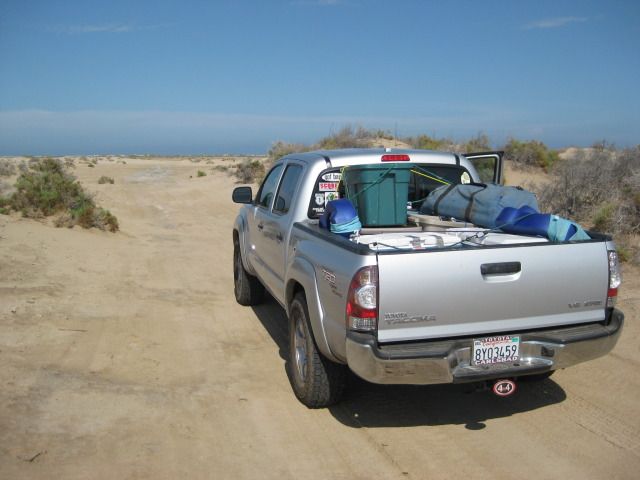
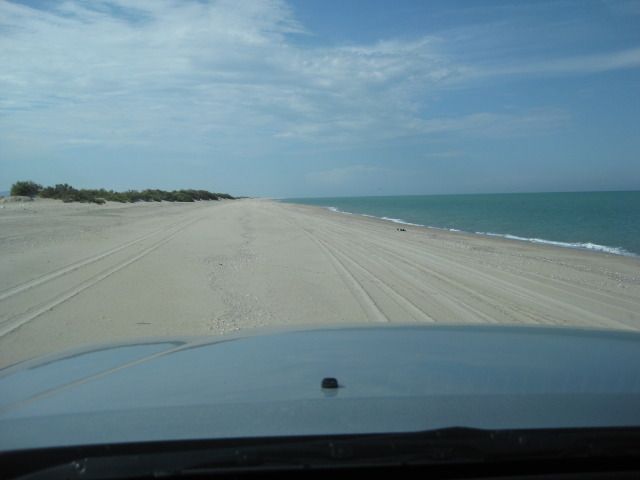
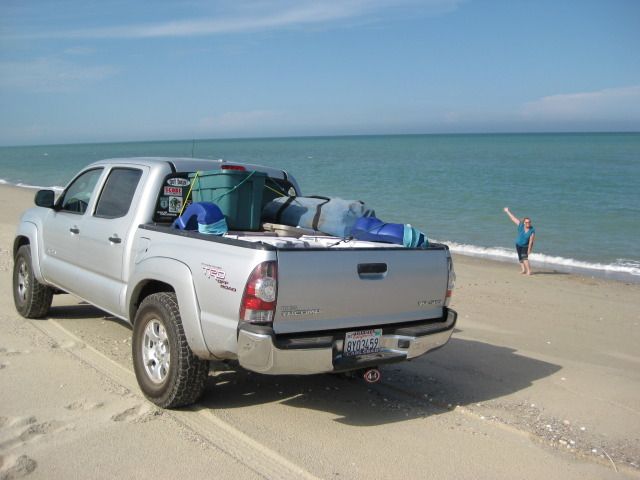
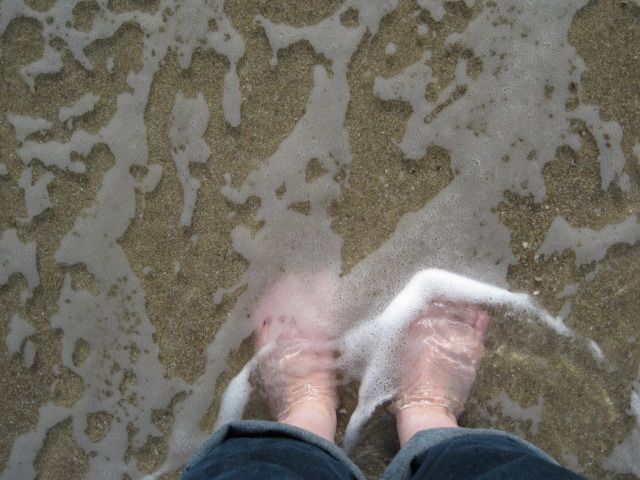

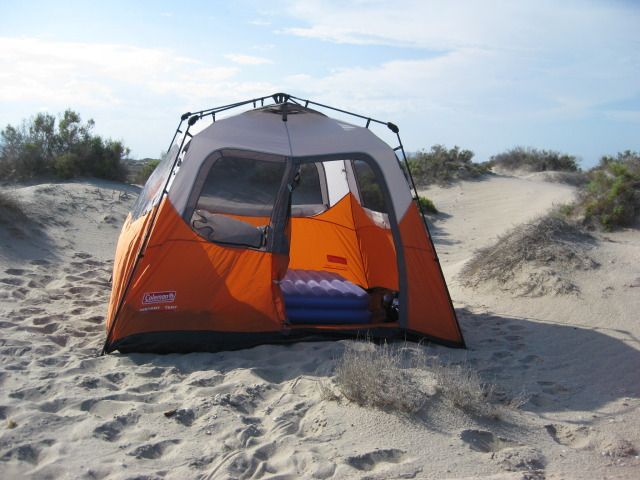
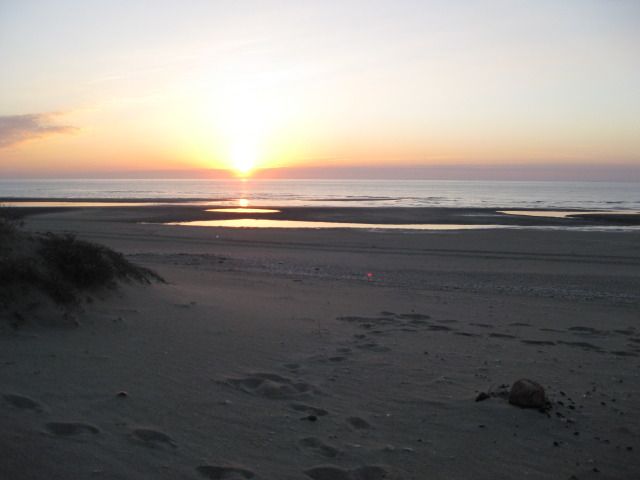
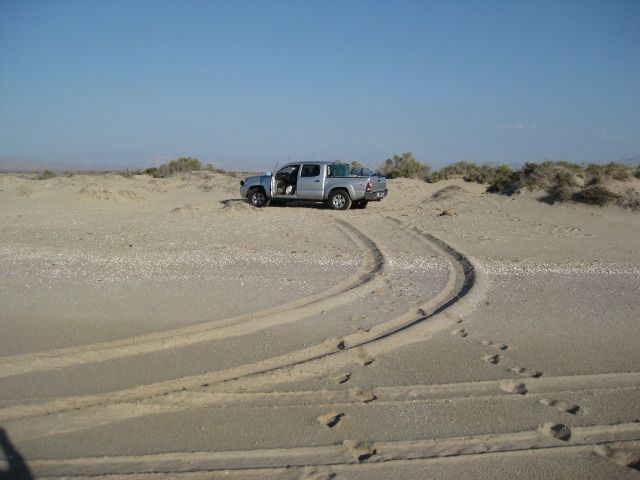
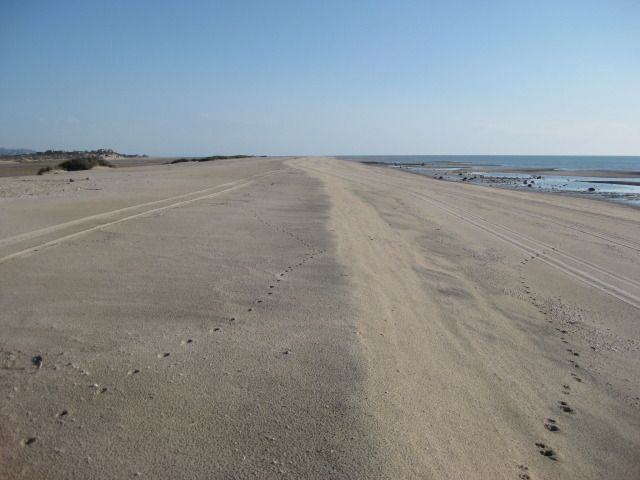

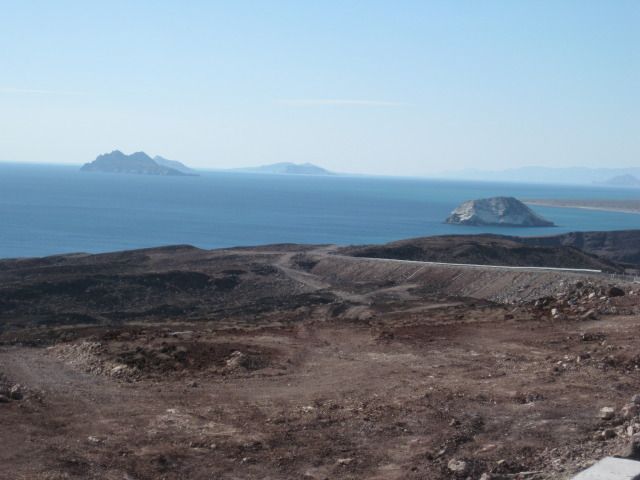
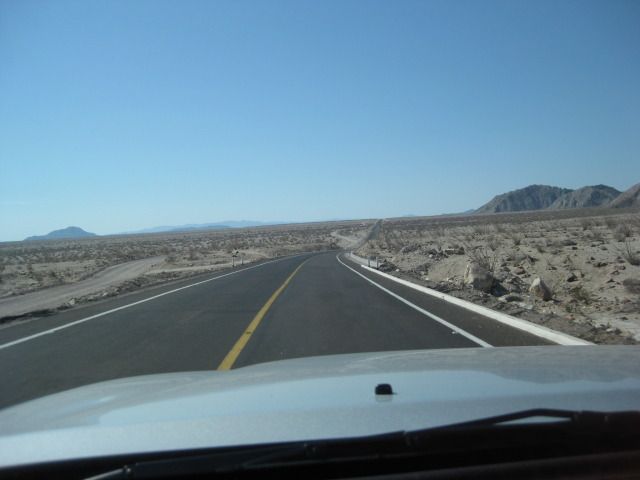
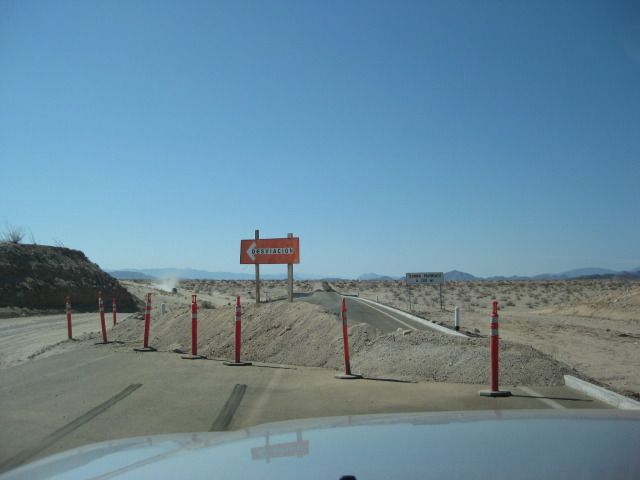
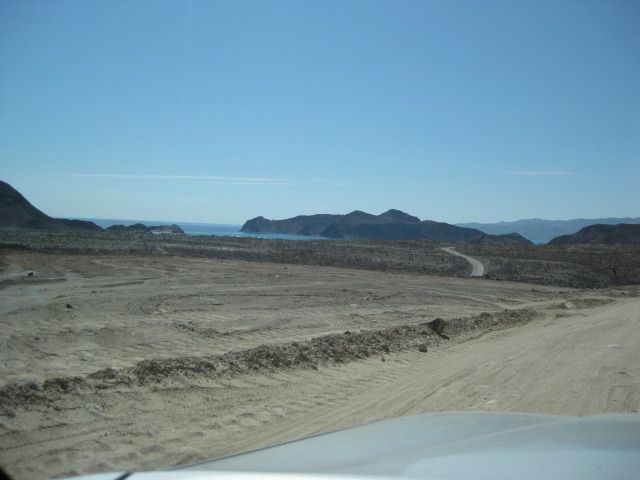
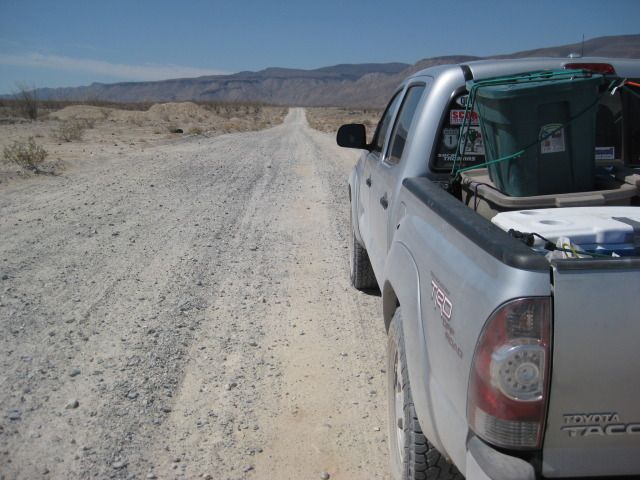
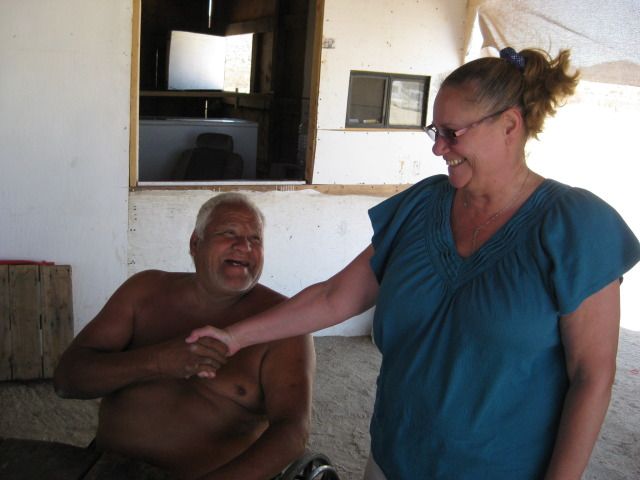
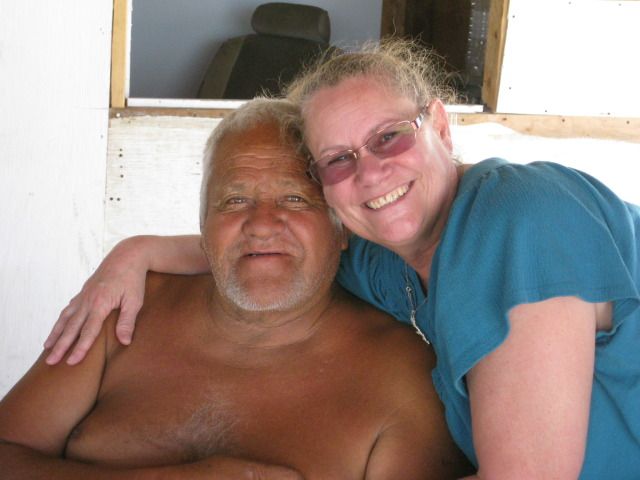

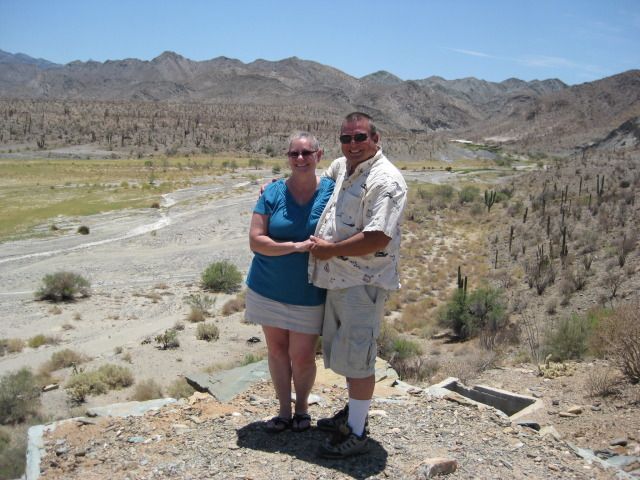
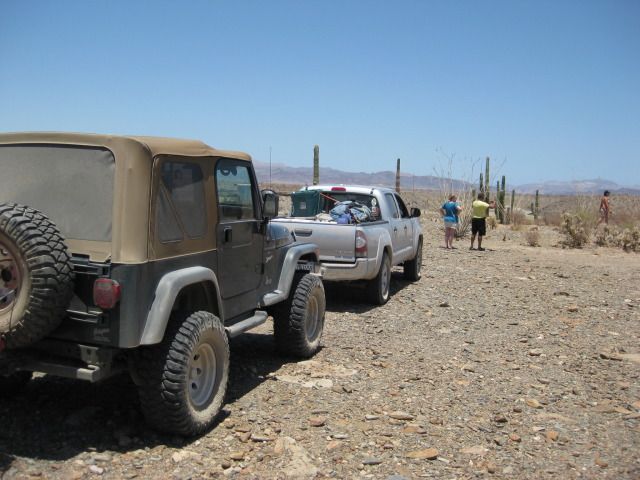
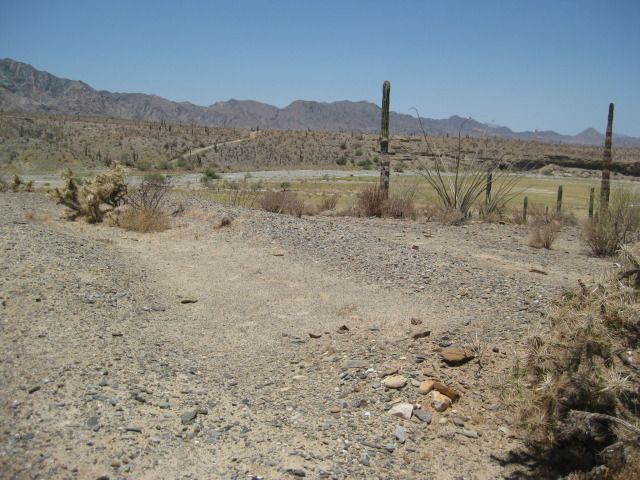
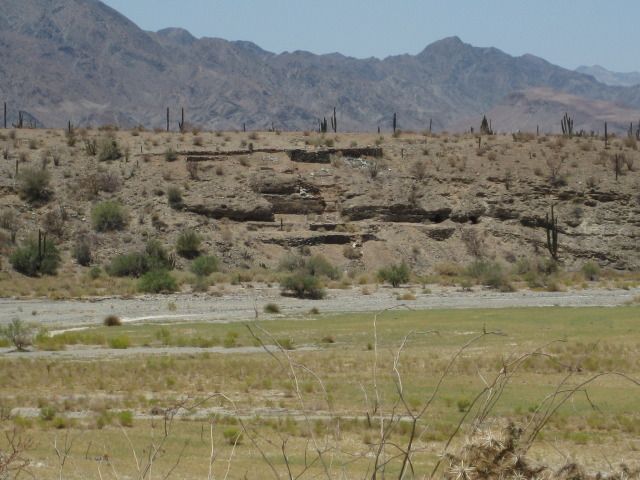
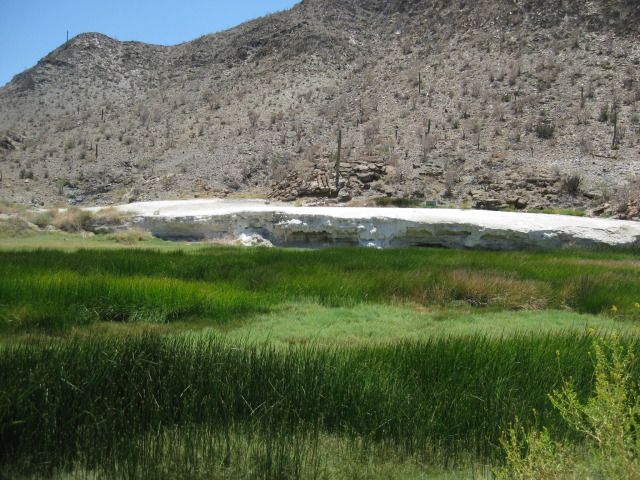

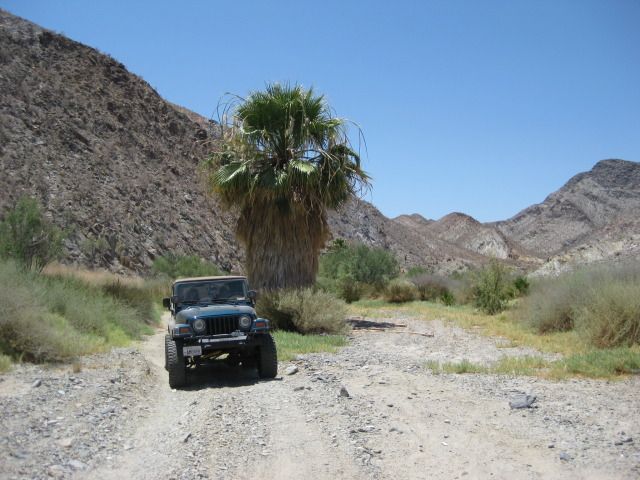
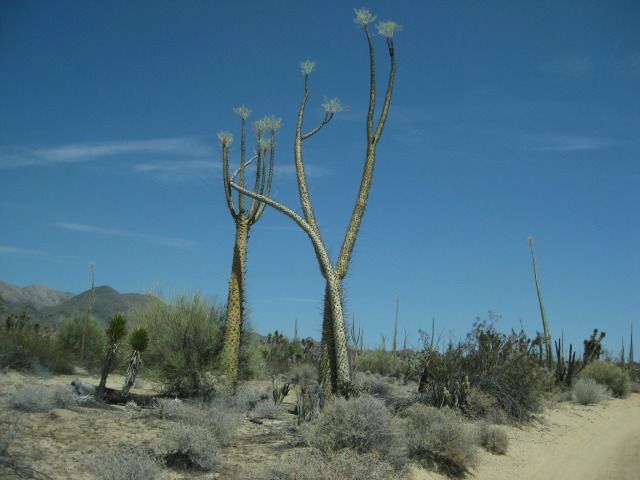

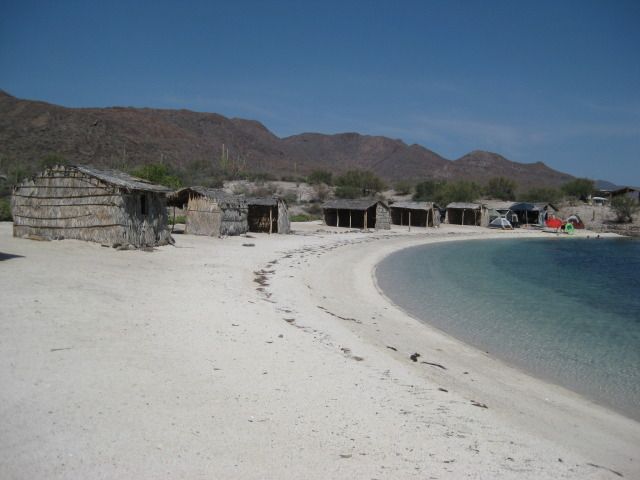
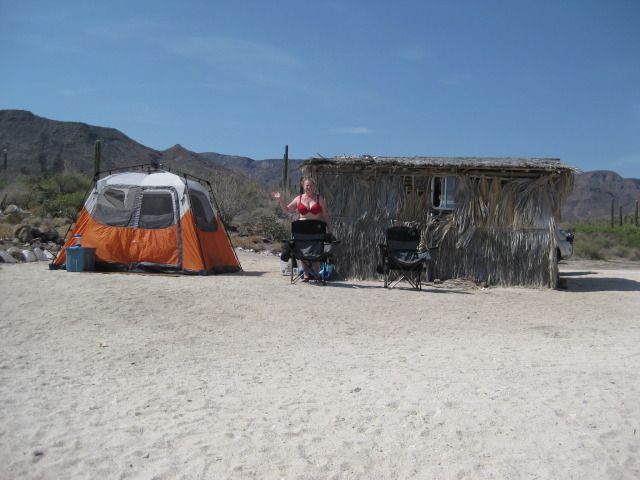
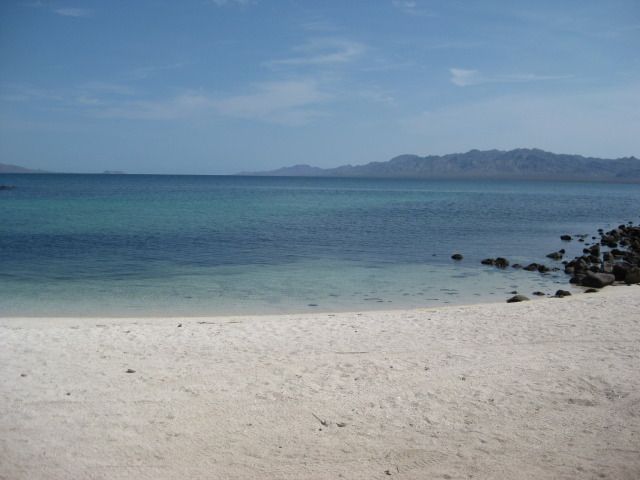

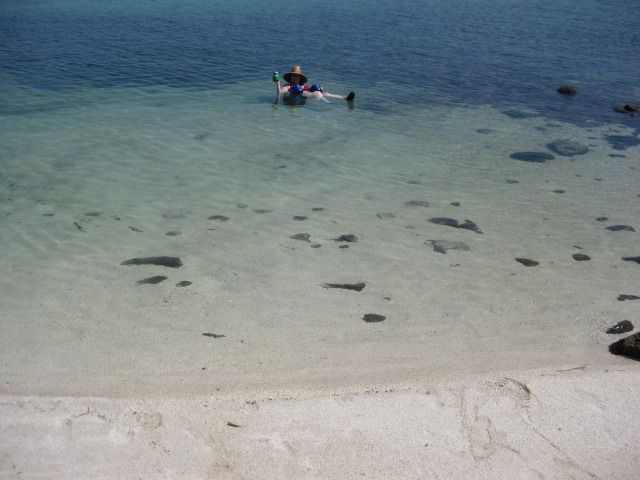

No comments:
Post a Comment